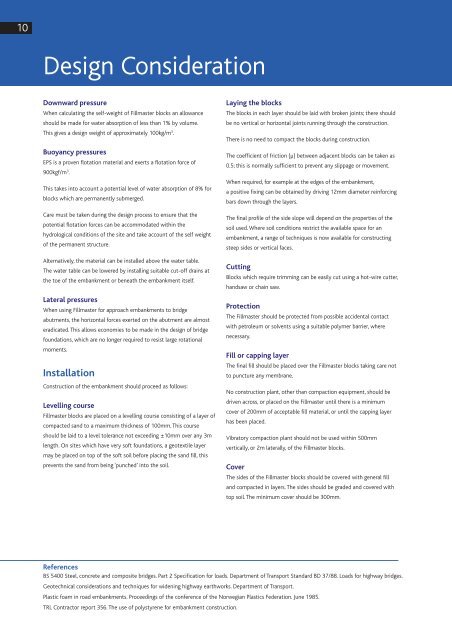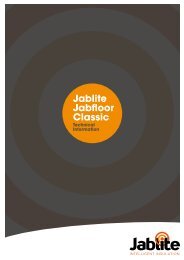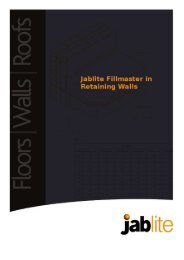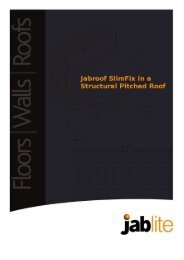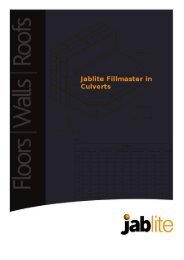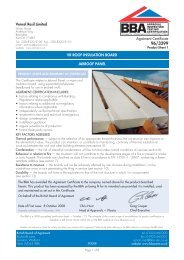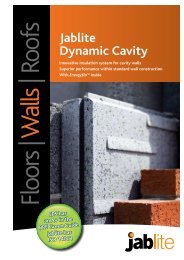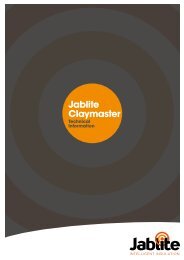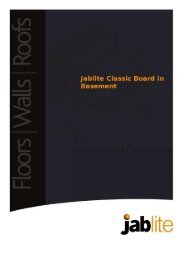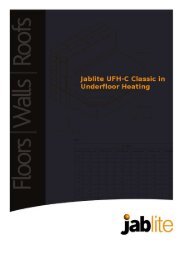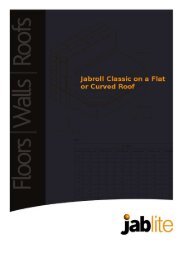Jablite Fillmaster in Landscaping
Jablite Fillmaster in Landscaping
Jablite Fillmaster in Landscaping
- No tags were found...
Create successful ePaper yourself
Turn your PDF publications into a flip-book with our unique Google optimized e-Paper software.
10Design ConsiderationDownward pressureWhen calculat<strong>in</strong>g the self-weight of <strong>Fillmaster</strong> blocks an allowanceshould be made for water absorption of less than 1% by volume.This gives a design weight of approximately 100kg/m 3 .Buoyancy pressuresEPS is a proven flotation material and exerts a flotation force of900kgf/m 3 .This takes <strong>in</strong>to account a potential level of water absorption of 8% forblocks which are permanently submerged.Care must be taken dur<strong>in</strong>g the design process to ensure that thepotential flotation forces can be accommodated with<strong>in</strong> thehydrological conditions of the site and take account of the self weightof the permanent structure.Alternatively, the material can be <strong>in</strong>stalled above the water table.The water table can be lowered by <strong>in</strong>stall<strong>in</strong>g suitable cut-off dra<strong>in</strong>s atthe toe of the embankment or beneath the embankment itself.Lateral pressuresWhen us<strong>in</strong>g <strong>Fillmaster</strong> for approach embankments to bridgeabutments, the horizontal forces exerted on the abutment are almosteradicated. This allows economies to be made <strong>in</strong> the design of bridgefoundations, which are no longer required to resist large rotationalmoments.InstallationConstruction of the embankment should proceed as follows:Levell<strong>in</strong>g course<strong>Fillmaster</strong> blocks are placed on a levell<strong>in</strong>g course consist<strong>in</strong>g of a layer ofcompacted sand to a maximum thickness of 100mm. This courseshould be laid to a level tolerance not exceed<strong>in</strong>g ±10mm over any 3mlength. On sites which have very soft foundations, a geotextile layermay be placed on top of the soft soil before plac<strong>in</strong>g the sand fill, thisprevents the sand from be<strong>in</strong>g ‘punched’ <strong>in</strong>to the soil.Lay<strong>in</strong>g the blocksThe blocks <strong>in</strong> each layer should be laid with broken jo<strong>in</strong>ts; there shouldbe no vertical or horizontal jo<strong>in</strong>ts runn<strong>in</strong>g through the construction.There is no need to compact the blocks dur<strong>in</strong>g construction.The coefficient of friction (µ) between adjacent blocks can be taken as0.5; this is normally sufficient to prevent any slippage or movement.When required, for example at the edges of the embankment,a positive fix<strong>in</strong>g can be obta<strong>in</strong>ed by driv<strong>in</strong>g 12mm diameter re<strong>in</strong>forc<strong>in</strong>gbars down through the layers.The f<strong>in</strong>al profile of the side slope will depend on the properties of thesoil used. Where soil conditions restrict the available space for anembankment, a range of techniques is now available for construct<strong>in</strong>gsteep sides or vertical faces.Cutt<strong>in</strong>gBlocks which require trimm<strong>in</strong>g can be easily cut us<strong>in</strong>g a hot-wire cutter,handsaw or cha<strong>in</strong> saw.ProtectionThe <strong>Fillmaster</strong> should be protected from possible accidental contactwith petroleum or solvents us<strong>in</strong>g a suitable polymer barrier, wherenecessary.Fill or capp<strong>in</strong>g layerThe f<strong>in</strong>al fill should be placed over the <strong>Fillmaster</strong> blocks tak<strong>in</strong>g care notto puncture any membrane.No construction plant, other than compaction equipment, should bedriven across, or placed on the <strong>Fillmaster</strong> until there is a m<strong>in</strong>imumcover of 200mm of acceptable fill material, or until the capp<strong>in</strong>g layerhas been placed.Vibratory compaction plant should not be used with<strong>in</strong> 500mmvertically, or 2m laterally, of the <strong>Fillmaster</strong> blocks.CoverThe sides of the <strong>Fillmaster</strong> blocks should be covered with general filland compacted <strong>in</strong> layers. The sides should be graded and covered withtop soil. The m<strong>in</strong>imum cover should be 300mm.ReferencesBS 5400 Steel, concrete and composite bridges. Part 2 Specification for loads. Department of Transport Standard BD 37/88. Loads for highway bridges.Geotechnical considerations and techniques for widen<strong>in</strong>g highway earthworks. Department of Transport.Plastic foam <strong>in</strong> road embankments. Proceed<strong>in</strong>gs of the conference of the Norwegian Plastics Federation. June 1985.TRL Contractor report 356. The use of polystyrene for embankment construction.


